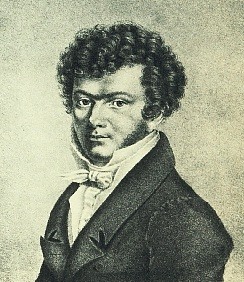Ferdinand Ries
(28 November 1784 – 13 January 1838) was a German composer. He was, after Ludwig van Beethoven, the most significant composer of the city of Bonn.
Ries was a friend, pupil and secretary of Ludwig van Beethoven.
When sixteen-year-old Ferdinand arrived on Beethoven’s doorstep in Vienna in 1801 with a letter of recommendation from his father Beethoven was already at the peak of his fame. Beethoven welcomed his fellow countryman with open arms and gladly took him on as his piano pupil. In return, Ferdinand dealt with Beethoven’s correspondence with publishers, copied Beethoven’s scores and carried out minor personal commissions. For lessons in composition, Beethoven sent Ferdinand to his own former teacher, Johann Georg Albrechtsberger.
For much of the twentieth century the composer Ferdinand Ries was known primarily as Beethoven’s friend and biographer. During his lifetime, however, he was renowned as a virtuoso pianist and composer throughout the whole of Europe. Ries left us about 300 works. He composed eight symphonies, a violin concerto, eight piano concertos, three operas, oratorios and numerous other works in many genres, including 26 string quartets.
Piano concerto no. 3 in C sharp minor, opus 55
Ilan Levin - pianist
Yishai Steckler - conductor
The Israeli Chamber Orchestra
Live performance from the Felicja Blumental international Music Festival
Tel-Aviv Museum of Fine Arts, May 2012
Piano Concerto No. 3 in C-sharp minor, Op. 55, by German composer Ferdinand Ries was written around 1813. It was composed in the proto-Romantic style, similar to the concertos of Johann Nepomuk Hummel, and anticipates stylistic developments of future Romantic composers.
Composition date
The manuscript bears the notation "St. Petersburg 1812", suggesting it was begun there (but the work may not have been finished there). In any case, it was probably (according to Allan Badley[1])
begun in 1812 and finished later, and most likely the fifth of Ries's eight piano concertos to be written (concerto no. 3 refers to the order of publication, not composition, and likewise for all of Ries's concertos).[2]
Connection to Franz Liszt
This piece, according to the diary of Adam Liszt, father of Franz Liszt, was the piano piece being played by Adam which "completely absorbed" Franz in his "sixth year"; following this he incessantly begged to be taught the piano.[3]
Movements
This work follows the traditional three-movement structure:
- Allegro maestoso
- Larghetto – (attacca)
- Rondo: Allegretto
The first movement bears a strong resemblance to the music of period composers such as J. N. Hummel, John Field, or Friedrich Kalkbrenner. The second theme is in A-flat major, rather than the
expected E major. The second movement, in A major anticipates the stylistic idiom of the music of
Frédéric Chopin. The third movement begins in C-sharp major, though this is indicated by accidentals, the key signature being that of C-sharp minor, in which key the movement (and the work) ends.
Maria Littauer, piano
Hamburg Symphony / Alois Springer
Rec. 1972
[2015. 6. 17. 1차]
'♣ 음악 감상실 ♣ > - 피아노' 카테고리의 다른 글
| Józef Wieniawski - Piano Concerto in G-minor, Op.20 (1858) (0) | 2020.12.04 |
|---|---|
| František Xaver Dušek: Piano concerto in E flat major (0) | 2020.12.03 |
| Jan Ladislav Dussek: Piano Concerto No. 11, 12 (0) | 2020.11.11 |
| Frederick Delius - Piano Concerto in C minor (0) | 2020.11.01 |
| Julius Röntgen - Piano Concerto No. 2 in D major, Op. 18 (0) | 2020.10.31 |
